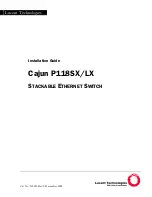
OPEN 812L VoIP ATA Router
User Guide
Page 85
OPEN Networks Pty Ltd
www.opennw.com
7.2.4 RIP System Wide Configuration
RIP (Routing Information Protocol) is a management protocol that ensures that all hosts in a
particular network share the same information about routing paths. In RIP, a host computer will
send its entire routing table to another host computer every X seconds, where X is the supply
interval. The receiving host computer will in turn repeat the same process by sending the same
information to another host computer. The process is repeated until all host computers in a
given network share the same routing knowledge.
There are several components to RIP, including the authenticator, supplier, and listener.
Authenticator
: Authentication is only available for RIPv2. When it is disabled, RIPv2
messages containing authentication entries are discarded. When it is enabled, all RIPv2
messages must have proper authentication entries, and all RIPv2 messages without verified
authentication entries and all RIPv1 messages are automatically rejected.
Supplier
: The RIP Supplier has two functions:
It transmits route updates over every RIP Supplier interface at the interval specified by
Supply
Interval
(see below).
It transmits route updates in response to specific requests from other routers.
Listener
: The RIP Listener listens to and processes all RIP messages it receives from other
RIP routers and updates the host routing tables accordingly. The RIP Listener is always
enabled when RIP is enabled. By default, RIP is disabled.
The announcement messages RIP sends are based on two configuration parameters: RIP
Version number and Multicast:
Version Multicast Announcements
Sent
1 OFF
V1
2 ON V1
2 OFF
V2-BC
2 ON V2-MC
The RIP messages that can be received and processed are based on two configuration
parameters: RIP Version number and Multicast:
Version Multicast Announcements
Sent
1 OFF
V1
2 ON V1
2 OFF
V2-BC
2 ON V2-MC
Follow the steps below to access and configure the
RIP System WIde Configuration
page.
















































